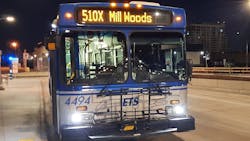Edmonton Transit Service (ETS) launched its redesigned bus network, new on-demand service and opened its new Mill Woods Transit Centre on April 25, marking the first time in about 20 years the system has undergone a significant refresh of its services.
“These projects support a strong and integrated transit network that is critical to building a great city where it’s safer, more convenient and greener to travel from one place to another,” said Edmonton Mayor Don Iveson.
While the number of bus routes has decreased, the frequency and service has increased on the new routes, creating a more integrated network with 93 percent of addresses within a five-to-seven-minute walk of a transit stop. ETS explains the new services meet the expectations of current riders and set a foundation for the city’s future growth.
“We’re very excited to see a modernized transit system coming to a street near you,” said Carrie Hotton-MacDonald, ETS branch manager. “This is a major step towards providing the type of service Edmontonians told us they want today and to meeting evolving transit expectations as our city grows in the future.”
The system will feature five new types of bus routes:
- Crosstown to connect suburban destinations without a trip downtown;
- Frequent, which carry headways of 15 minutes or better;
- Community, which connect seniors’ residences with nearby services;
- Local to provide neighborhood connections; and
- Rapid, which are express routes with limited stops that connect suburbs to downtown.
The new types of bus routes are in addition to the special school routes and late-night Owl routes ETS will operate.
To complement the new bus system will be Canada’s largest on-demand service that will use 57 accessible shuttles to connect 37 neighborhoods and seniors’ residences to nearby designated transit hubs. ETS explains its on demand transit service is provided in areas where it is a better fit than regular bus service. It has the advantage of providing service seven days a week and with the same or better frequency than scheduled service.
“Transit influences where Edmontonians live, work and play. With that in mind, we’re building the foundation for a strong transit system that will help create a vibrant city for people today and those we’ll welcome tomorrow,” ETS said in a release announcing the start of the new network.
The third major piece of ETS’ new network is the opening of the Mill Woods Transit Centre, which is designed to simplify how customers get to their bus or light-rail connections. The C$17.4-million (US$13.95 million) transit center includes a covered walkway that provides a connection to nearby Mill Woods Stop on the Valley Line Southeast LRT, which is scheduled to open later in 2021.
“An integrated transit network not only provides easy access to our city but supports lively neighborhoods through transit-oriented development. For example, Mill Woods Transit Centre was moved closer to the new LRT to support redevelopment plans for the Mill Woods Town Centre area. It will become a higher-density center that includes mixed residential housing and commercial businesses within walking distance to transit,” said ETS.
About the Author

Mischa Wanek-Libman
Group Editorial Director
Mischa Wanek-Libman is director of communications with Transdev North America. She has more than 20 years of experience working in the transportation industry covering construction projects, engineering challenges, transit and rail operations and best practices.
Wanek-Libman has held top editorial positions at freight rail and public transportation business-to-business publications including as editor-in-chief and editorial director of Mass Transit from 2018-2024. She has been recognized for editorial excellence through her individual work, as well as for collaborative content.
She is an active member of the American Public Transportation Association's Marketing and Communications Committee and served 14 years as a Board Observer on the National Railroad Construction and Maintenance Association (NRC) Board of Directors.
She is a graduate of Drake University in Des Moines, Iowa, where she earned a Bachelor of Arts degree in Journalism and Mass Communication.
